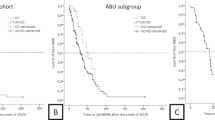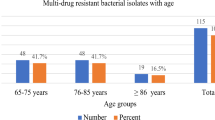Abstract
Introduction:
Urinary tract infections (UTI) are a major public health problem among spinal cord injury (SCI) patients. They frequently involve multidrug-resistant (MDR) bacteria. Ceftolozane/tazobactam (C/T) is a novel antibiotic combination approved for complicated intra-abdominal and UTI caused by Gram-positive and Gram-negative organisms, including some MDR strains. Little is known about the use of this agent for complicated febrile UTI occurring among SCI patients with neurogenic bladder due to MDR Pseudomonas aeruginosa (PSA).
Case presentation:
We describe the case of a 35-year-old man with SCI due to multiple sclerosis, with a neurogenic bladder necessitating a bilateral nephrostomy and double J catheter, who developed a febrile UTI due to a MDR PSA, which was susceptible only to amikacin and colistin. Because of this MDR phenotype and the underlying kidney disease, a 1000 mg (1000 mg per 500 mg) dose of C/T was given as monotherapy every 8 h for 7 days, after 3 days of colistin and amikacin. Thanks to this treatment, the patient had a favorable outcome with no clinical signs of UTI or positive urine culture up to 1 month after diagnosis.
Discussion:
C/T seems to be an effective and safe therapeutic option for febrile UTI due to MDR PSA in SCI patients with neurogenic bladder, even when administered in monotherapy for 10 days.
Similar content being viewed by others
Log in or create a free account to read this content
Gain free access to this article, as well as selected content from this journal and more on nature.com
or
References
Cubist Pharmaceuticals Inc. Zerbaxa (ceftolozane/tazobactam) for injection, for intravenous use (package insert). 2014. Available at http://www.accessdata.fda.gov/drugsatfda_docs/label/2014/206829lbl.pdf (accessed 19 September 2016).
Hong M-C, Hsu DI, Bounthavong M . Ceftolozane/tazobactam: a novel antipseudomonal cephalosporin and β-lactamase-inhibitor combination. Infect Drug Resist 2013; 6: 215–223.
Dinh A, Toumi A, Blanc C, Descatha A, Bouchand F, Salomon J et al. Management of febrile urinary tract infection among spinal cord injured patients. BMC Infect Dis 2016; 16: 156.
Farrell DJ, Flamm RK, Sader HS, Jones RN . Antimicrobial activity of ceftolozane-tazobactam tested against Enterobacteriaceae and Pseudomonas aeruginosa with various resistance patterns isolated in U.S. Hospitals (2011–2012). Antimicrob Agents Chemother 2013; 57: 6305–6310.
Solomkin J, Hershberger E, Miller B, Popejoy M, Friedland I, Steenbergen J et al. Ceftolozane/tazobactam plus metronidazole for complicated intra-abdominal infections in an era of multidrug resistance: results from a randomized, double-blind, Phase 3 Trial (ASPECT-cIAI). Clin Infect Dis 2015; 60: 1462–1471.
Wagenlehner FM, Umeh O, Steenbergen J, Yuan G, Darouiche RO . Ceftolozane-tazobactam compared with levofloxacin in the treatment of complicated urinary-tract infections, including pyelonephritis: a randomised, double-blind, phase 3 trial (ASPECT-cUTI). Lancet 2015; 385: 1949–1956.
Castón JJ, De la Torre Á, Ruiz-Camps I, Sorlí ML, Torres V, Torre-Cisneros J . Salvage therapy with ceftolozane/tazobactam for multidrug resistant Pseudomonas aeruginosa infections. Antimicrob Agents Chemother 2016; 61: e02136-16.
Miller B, Popejoy MW, Hershberger E, Steenbergen JN, Alverdy J . Characteristics and outcomes of complicated intra-abdominal infections involving Pseudomonas aeruginosa from a randomized, double-blind, Phase 3 ceftolozane-tazobactam study. Antimicrob Agents Chemother 2016; 60: 4387–4390.
Dinh A, Saliba M, Saadeh D, Bouchand F, Descatha A, Roux AL et al. Blood stream infections due to multidrug-resistant organisms among spinal cord-injured patients, epidemiology over 16 years and associated risks: a comparative study. Spinal Cord 2016; 54: 720–725.
Karlowsky JA, Draghi DC, Jones ME, Thornsberry C, Friedland IR, Sahm DF . Surveillance for antimicrobial susceptibility among clinical isolates of Pseudomonas aeruginosa and Acinetobacter baumannii from hospitalized patients in the United States, 1998 to 2001. Antimicrob Agents Chemother 2003; 47: 1681–1688.
Nathwani D, Raman G, Sulham K, Gavaghan M, Menon V . Clinical and economic consequences of hospital-acquired resistant and multidrug-resistant Pseudomonas aeruginosa infections: a systematic review and meta-analysis. Antimicrob Resist Infect Control 2014; 3: 32.
Obritsch MD, Fish DN, MacLaren R, Jung R . National surveillance of antimicrobial resistance in Pseudomonas aeruginosa isolates obtained from intensive care unit patients from 1993 to 2002. Antimicrob Agents Chemother 2004; 48: 4606–4610.
Kang C-I, Kim S-H, Kim H-B, Park S-W, Choe Y-J, Oh M-D et al. Pseudomonas aeruginosa bacteremia: risk factors for mortality and influence of delayed receipt of effective antimicrobial therapy on clinical outcome. Clin Infect Dis 2003; 37: 745–751.
Lodise TP, Patel N, Kwa A, Graves J, Furuno JP, Graffunder E et al. Predictors of 30-day mortality among patients with Pseudomonas aeruginosa bloodstream infections: impact of delayed appropriate antibiotic selection. Antimicrob Agents Chemother 2007; 51: 3510–3515.
McCarthy K . Pseudomonas aeruginosa: evolution of antimicrobial resistance and implications for therapy. Semin Respir Crit Care Med 2015; 36: 44–55.
Morata L, Cobos-Trigueros N, Martínez JA, Soriano A, Almela M, Marco F et al. Influence of multidrug resistance and appropriate empirical therapy on the 30-day mortality rate of Pseudomonas aeruginosa bacteremia. Antimicrob Agents Chemother 2012; 56: 4833–4837.
Osih RB, McGregor JC, Rich SE, Moore AC, Furuno JP, Perencevich EN et al. Impact of empiric antibiotic therapy on outcomes in patients with Pseudomonas aeruginosa bacteremia. Antimicrob Agents Chemother 2007; 51: 839–844.
Traugott KA, Echevarria K, Maxwell P, Green K, Lewis JS . Monotherapy or combination therapy? The Pseudomonas aeruginosa conundrum. Pharmacotherapy 2011; 31: 598–608.
Obritsch MD, Fish DN, MacLaren R, Jung R . Nosocomial infections due to multidrug-resistant Pseudomonas aeruginosa: epidemiology and treatment options. Pharmacotherapy 2005; 25: 1353–1364.
Oie S, Sawa A, Kamiya A, Mizuno H . In-vitro effects of a combination of antipseudomonal antibiotics against multi-drug resistant Pseudomonas aeruginosa. J Antimicrob Chemother 1999; 44: 689–691.
Oie S, Uematsu T, Sawa A, Mizuno H, Tomita M, Ishida S et al. In vitro effects of combinations of antipseudomonal agents against seven strains of multidrug-resistant Pseudomonas aeruginosa. J Antimicrob Chemother 2003; 52: 911–914.
Hooton TM, Bradley SF, Cardenas DD, Colgan R, Geerlings SE, Rice JC et al. Diagnosis, prevention, and treatment of catheter-associated urinary tract infection in adults: 2009 international clinical practice guidelines from the Infectious Diseases Society of America (IDSA). Clin Infect Dis 2010; 50: 625–663.
Acknowledgements
We thank Elodie Choisy for her help. The patient consent was obtained.
Author information
Authors and Affiliations
Corresponding author
Ethics declarations
Competing interests
The authors declare no conflict of interest.
Rights and permissions
About this article
Cite this article
Dinh, A., Davido, B., Calin, R. et al. Ceftolozane/tazobactam for febrile UTI due to multidrug-resistant Pseudomonas aeruginosa in a patient with neurogenic bladder. Spinal Cord Ser Cases 3, 17019 (2017). https://doi.org/10.1038/scsandc.2017.19
Received:
Revised:
Accepted:
Published:
DOI: https://doi.org/10.1038/scsandc.2017.19
This article is cited by
-
Real-world use of ceftolozane/tazobactam: a systematic literature review
Antimicrobial Resistance & Infection Control (2021)



